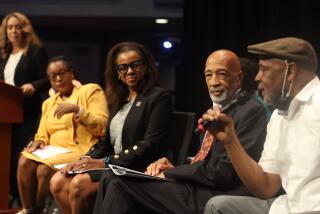Panel Calls for Attack on Race Bias in Courts
- Share via
SAN FRANCISCO — California’s influential Judicial Council, reviewing research that suggests whites fare significantly better than minorities in court, called Wednesday for reforms to attack widely reported racism and bias in the state’s legal arena.
The council, which sets policy for state courts, acted after receiving a six-year study that found both documented and perceived disparity between the treatment of minorities and whites in courtrooms. The study by a council committee cited research that suggested whites are more likely than others to have charges dropped or reduced, and that the percentage of whites in prison is significantly smaller than the proportion of whites who commit violent crimes.
The report also said that minorities, predominantly African Americans, comprise the majority of those in prison, jail, on probation or on parole. In California, 33.2% of African American, 12.3% of Latino and 6.7% of white men are under control of the criminal justice system.
A committee of lawyers and judges, including two retired state Supreme Court justices, began the study in 1991 at the direction of the Judicial Council. The findings are based largely on hearings and surveys.
“The advisory committee found a persistent perception among minorities that the justice system gives scant attention or resources to investigating crimes against minorities,” the report said, “and that defendants who are minorities receive harsh treatment compared to white defendants in similar circumstances.”
Some of the lawyers and judges who spoke to the committee complained of racist behavior on the bench, prompting the committee to include in its recommendations “cultural” training for the overwhelmingly white judiciary.
“In some instances,” the study said, “judicial officers were reported as making overtly racist comments.”
An unidentified Los Angeles Municipal Court judge told the committee of hearing two other judges at a seminar suggest that jail time might be more appropriate for blacks than for whites or Asians. The judges reasoned that going to jail does not carry a stigma in the African American community.
The council voted to accept the report and direct a committee to prepare a list of recommended reforms, which are expected to be proposed within the next few months.
The recommendations in the report included hiring more interpreters for courts, finding ways to enlarge the pool of minorities who could serve as judges, putting more minorities on grand juries and making court officials more sensitive to ethnic concerns.
The study prompted sharp debate among members of the Judicial Council, which primarily consists of judges. Court of Appeal Justice Arthur G. Scotland said he was concerned that the news media would now label the judicial system racist when in fact the report consisted primarily of impressions.
“People come to your court and lose their case and perceive they lost the case for reasons other than it had no merit,” Scotland argued.
He cited a study finding that most incarcerated children are minorities even though white children account for 75% of all juveniles arrested. Scotland complained that the study should have examined whether differing offenses might explain the statistic.
But other council members strongly defended the report, contending it contained examples of racism they themselves have encountered.
“These stories are legion,” said Oakland Municipal Judge Brenda Harbin-Forte, an African American. “There are hundreds if not thousands of us who were former attorneys and now judges . . . who could tell these types of stories.”
Assemblywoman Martha M. Escutia, (D-Huntington Park) who now heads the state Assembly Judiciary Committee, was even more emphatic. “I have been there,” said the Latina lawmaker. “I felt the report . . . told my story.”
She told of working as a research attorney for a judge who belittled her and later in a law firm where a minority woman could never hope to make partner.
Even now in the Legislature, she said, she must endure racist remarks and questions about why she speaks with an accent even though she was born in the United States.
Turning to Justice Scotland, who serves in Sacramento, she said: “Come to Huntington Park and East Los Angeles courts, and you will see a whole different way of life.”
A separate study released Wednesday by the Washington-based Sentencing Project, a liberal advocacy group, also cited a bias in the legal system nationwide.
The national report said racial disparities in sentencing increased from 1988 to 1994, partly because of a huge increase in the percentage of blacks imprisoned for drug offenses. A dozen states incarcerate African Americans at a rate more than 10 times that of whites, the project said.
National statistics also “appear to demonstrate” that whites succeed more often than minorities at every step in pretrial negotiations, according to the Judicial Council study. This may be partially due to the disparate impact of drug laws and police policies that target minority communities, the report said.
Non-English speakers have inadequate access to the courts, the state report said, and some California police departments “routinely” stop and search minorities if they are looking for a minority suspect or if a minority is seen in a predominantly white neighborhood.
State Supreme Court Chief Justice Ronald M. George, who heads the Judicial Council, pledged that the report would “not gather dust on a shelf.”
“It is never easy to be self-critical,” George said. “Nevertheless, only through open, honest and aggressive self-analysis can we best achieve our goals.”
Legal affairs writer Henry Weinstein contributed to this report from Los Angeles.
More to Read
Get the L.A. Times Politics newsletter
Deeply reported insights into legislation, politics and policy from Sacramento, Washington and beyond. In your inbox twice per week.
You may occasionally receive promotional content from the Los Angeles Times.











